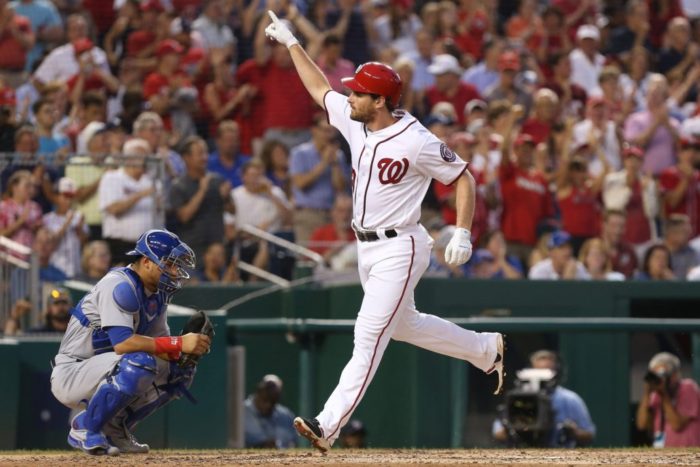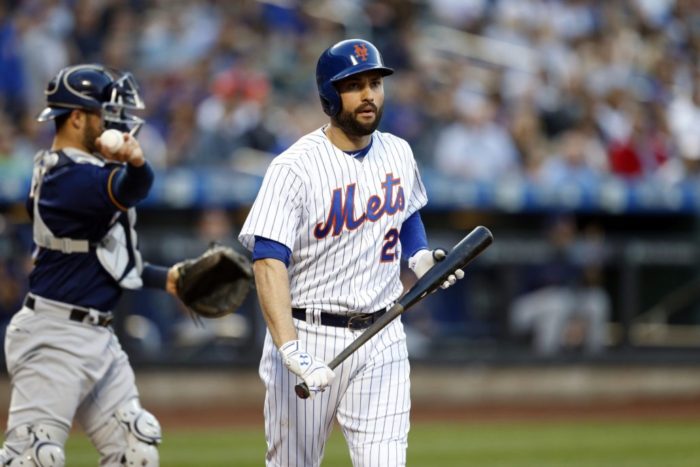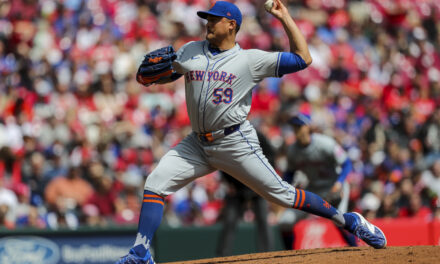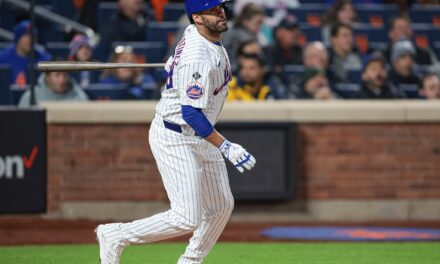
When looking at the Mets’ struggles this season, there is one explanation that immediately comes to everyone’s mind – Injuries.
But injuries do not tell the whole story. There are deeper issues afflicting the team, and many of them are the result of General Manager Sandy Alderson.
First, let’s look at what I think is the most underrated problem. There are many highly touted prospects Alderson acquired who have not lived up to expectations.
The Disappointments:
Zack Wheeler: Acquired from the Giants in 2011 for Carlos Beltran. He was rated the MLB’s 11th best prospect by Baseball America in 2013.
Wheeler missed the entire 2015 and 2016 seasons recovering from Tommy John surgery, and has struggled since returning. Wheeler has a 5.21 ERA and 1.57 WHIP in 17 starts this season with 40 walks in 86 innings.
He is currently on the disabled list due to a stress reaction in his right arm. He owns a career 21-23 record, 3.90 ERA and 4.06 FIP across three seasons.
Travis d’Arnaud: Acquired from the Blue Jays in 2012 along with Noah Syndergaard, Wuilmer Becerra and John Buck in exchange for R.A Dickey, Josh Thole and Mike Nickeas. He was rated the MLB’s 23rd best prospect by Baseball America in 2013.
D’Arnaud only played more than 100 games once in his career, and he owns a career .241/.303/.394 batting line over five seasons. This year, the 28-year-old catcher is slashing .225/.272/.398 with ten homeruns and 37 RBI in 268 plate appearances.
The disappointments of these two players cannot be overstated. Wheeler was once thought of as the future ace of the rotation, and d’Arnaud was viewed as a potential all-star catcher. They have both combined for a total of 0.7 wins above replacement this year in what was supposed to be the prime of their careers.
Let’s move on to four prospects who weren’t quite as highly ranked, but were still considered inside the MLB’s top 100.
Brandon Nimmo: 2011 first round pick (13th overall): Rated the MLB’s 45th best prospect by Baseball America in 2015.
After seven years in system, Nimmo has been surpassed on the depth chart and is currently on the major league bench. The-24-year-old outfielder has a .262/.347/.308 triple slash line in 121 big league plate appearances, and slumped with a .227/.364/.368 batting line in 194 plate appearances in Triple-A Las Vegas earlier this season.
Gavin Cecchini: 2012 First Round Pick (12th overall): Rated the MLB’s 87th best prospect by MLB.com in 2016.
While Cecchini has heated up of late, he is batting .267 overall with six home runs and has a .709 OPS in 110 games this season in Triple-A Las Vegas.
Rafael Montero: Signed by the Mets as an international free agent in 2011: Rated the MLB’s #68 best prospect by Baseball America in 2014.
Montero owns a career 2-13 record in the majors with a 5.47 ERA, 1.69 WHIP and 4.81 FIP in 21 starts and 26 relief appearances.
Kevin Plawecki: 2012 supplemental first round pick (35th overall) as compensation for losing Jose Reyes to Free Agency: Rated the MLB’s 63rd best prospect by Baseball America in 2015.
Though Plawecki is batting .326 with nine homeruns in 63 games in Triple-A, the 26-year-old Catcher has hit .202 with a .560 OPS in 437 career major league plate appearances.
While it’s possible these four players become late bloomers, their current numbers are not encouraging. Nimmo and Cecchini’s Triple-A stats regressed significantly after last year’s promising showing, and Plawecki and Montero have not made a positive impact in the majors despite extended chances.
Some will counter this point by saying the emergence of Michael Conforto and Noah Syndergaard compensate for these player’s struggles, but that brings me to my next argument.
The minor league system under Alderson was supposed to be one of the deepest in the league only a few years ago. And other than Conforto and Syndergaard, none of those prospects have panned out.
The Mets were loaded with solid lower level prospects such as Luis Mateo, Jack Leathersich Matt Reynolds Logan Verrett, Gabriel Ynoa, L.J. Mazzilli, Daniel Muno, Cory Mazzoni, and Wuilmer Becerra, who are just some examples, but all of them either flamed out or no longer look promising.
Recently called up Amed Rosario and Dominic Smith look exciting now, but it is too early to say if they are ultimately successes or failures.
And while Seth Lugo and Robert Gsellman looked like diamonds in the rough a year ago, they have been underwhelming this season as well. Lugo has a 4.85 ERA in 68.2 innings this season (4.48 FIP), and Gsellman has a 5.98 ERA in 81.1 innings (5.18 FIP).

The Ones That Got Away:
Daniel Murphy: Signed a 3-year $39 million-dollar contract with The Washington Nationals as a free agent in 2016.
Justin Turner: Released by the Mets in 2013.
Since leaving the Mets, Murphy has been one of the best hitters in the game. He is batting .329/.382/.570 with 20 homeruns and 78 RBI in 109 games this season. Last year, he led the league in slugging percentage (.595) and OPS (.985) and finished second in MVP voting.
Turner has also emerged as an MVP candidate since leaving New York. Turner is batting .345/.434/.567 with 17 homeruns and 55 RBI in 93 games this year for the Dodgers.
Some will argue Michael Fulmer should be included, but I disagree since the Mets received Yoenis Cespedes for him. I wanted to focus on players who left without getting any value back.
The common argument defending these moves is always that “nobody could have seen them developing into stars.” But that’s not a compelling argument, especially in Murphy’s case.
In spring training of 2015, hitting coach Kevin Long knew a breakthrough for Murphy was imminent. “Murphy,’’ Long said. “A batting title is not out of his grasp. He’s got a lot of pop and a lot of potential. There is more ability in there and we are going to try to draw it out.’’ (Kevin Kernan, NY Post)
That is exactly what Long accomplished. Murphy’s explosion started while he was still a Met in the final two months of 2015 and then it continued in the postseason as he batted .328 with seven homeruns and a 1.115 OPS in 14 games. Long saw it coming, and anyone who watched Murphy mash in that extraordinary postseason knew there was a possibility he could succeed at an elite level in the years to come.
While it’s true that nobody saw Turner becoming a star, he did not deserve to be released. He proved to be a good contact hitter off the bench with a .280 average and .704 OPS in his final Mets’ season, and at times, showed flashes of potential. In 2011, he won National League rookie of the month award in May where he set a franchise rookie record for most consecutive games with an RBI at seven.
Perhaps these two decisions could be excused if not for the fact that Alderson’s specialty was supposed to be his ability to evaluate under the radar talent. In his days with Oakland, he was heralded for finding undervalued players for the cash strapped A’s, but with the Mets, he inherited these types of players and let them slip away.
Other examples include Collin McHugh, who was traded to the Rockies for Eric Young Jr. McHugh had a three year stretch where he went 43-26 with a 3.71 ERA for Houston. And there’s also Matthew Bowman, who the Mets lost in the Rule five draft. Bowman had a 3.50 ERA and 1.14 WHIP over the past two years in the 115.2 innings out of the Cardinals bullpen.

Expensive Mistakes
Around the time Alderson was hired, the now former Mets’ Vice President of Player Development, Paul DePodesta, once said the new Mets era would be like “Moneyball with money.” It was a signal that the days of spending big money on bad contracts was a thing of the past, and the Mets would now use their cash wisely.
But the Front Office has not lived up to the expectations they set themselves. Their three highest paid players in 2017, Yoenis Cespedes, David Wright and Neil Walker salaries combined for $59.7 million to the payroll, yet they have combined for two 2.8 wins above replacement.
Cespedes’ fWAR stands at 1.1 in 71 games this season, while Walker’s is 1.7 in 76 games.
Some will say it’s unfair to include Wright in this calculation as his injury prevented him from playing, but the bottom line is abysmal. To spend that much money and receive that little production cannot be considered anything other than a failure, regardless of the circumstance.
It’s also hypocritical to rationalize these results when Alderson’s predecessor, Omar Minaya, was not given excuses when his high priced players fell victim to injuries or struggled unexpectedly. For example, Johan Santana, like Wright, had his career derailed by injuries, yet Minaya was still held accountable for that contract.
I expect the responses to all these points to say that Alderson’s plan was still intelligent. That his process was sound, and the results just didn’t pan out this year.
But the results are all that matter in the end, and stating what should have been, if not for injuries, does not change the reality that Alderson’s 2017 Mets have failed miserably.
The amount of injuries the Mets suffered should also not absolve Alderson from criticism since many of them were not unforeseen. Heading into the season, the Mets had four of their best five starters returning from surgery. The rotation was a ticking time bomb, and everyone should have seen it coming.
It’s worth noting that studies, like this one from Baseball Prospectus, find the best predictors of future injuries is past injuries, especially for pitcher’s elbows and shoulders. So the hope that the injury bug will be a thing of the past in 2018 is foolish.
This isn’t to say Alderson hasn’t made his share of excellent moves. Alderson deserves heaps of credit for making it to the World Series in 2015 and the Wild Card in 2016. But if that is the peak of his tenure, then it is a failure.
When Alderson was hired, his goal was sustained success. And after seven years and an arduous rebuilding process, the Mets are back at the bottom of the standings.
Fans shouldn’t be satisfied with one World Series defeat and a Wild Card loss. Previous general managers, like Steve Phillips, reached these same goals, yet were ultimately considered failures. Phillips’ team made it to the 2000 World Series and the playoffs in 1999, while Minaya’s 2006 squad came just one Adam Wainwright curveball away from a pennant too.
We all expected more from Alderson.
















